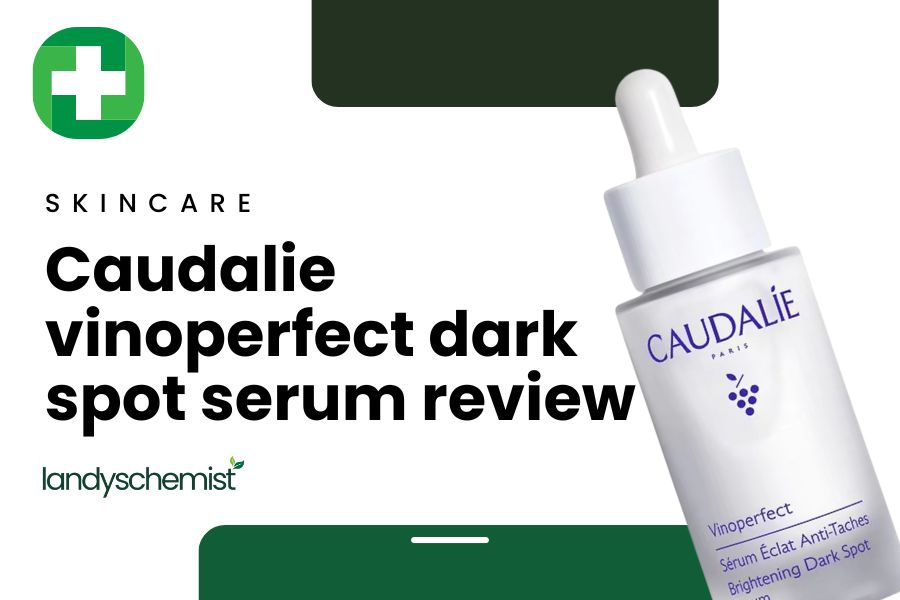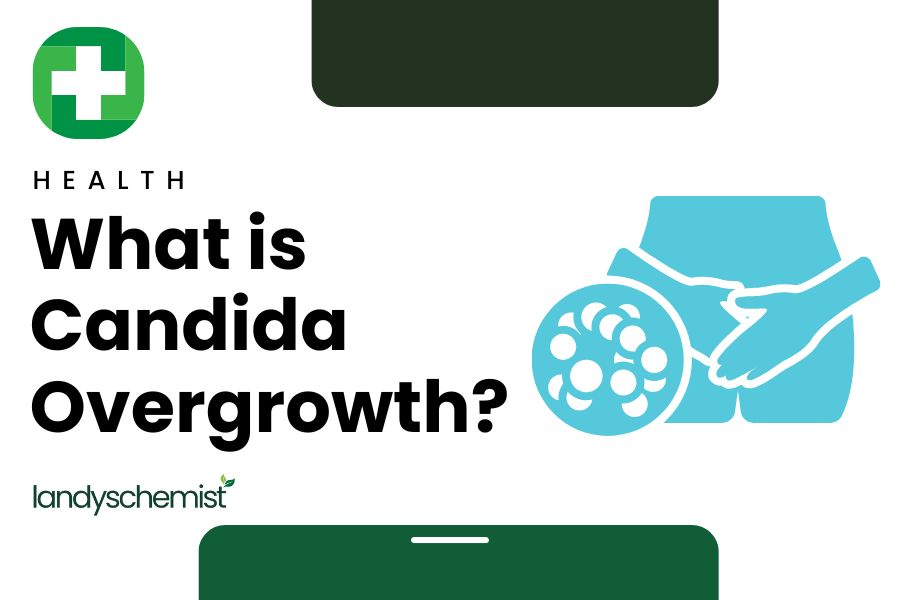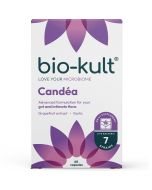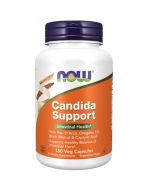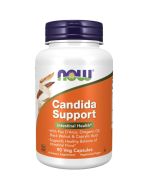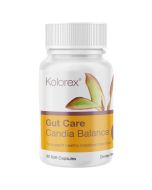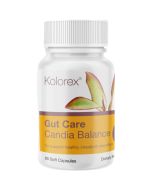
What Is Candida Overgrowth?
What is Candida?
Candida is a type of yeast (i.e a type of fungus) that naturally lives in small amounts on the skin, in the mouth, gut, and vaginal tract. It’s usually harmless, but when it grows out of control, it can cause infections known as candidiasis.
The most common types of Candida infections are:
- Oral thrush: A white coating in the mouth and throat
- Vaginal thrush: Itching, discharge, and irritation in the vaginal area
- Cutaneous candidiasis: A skin infection, often in warm, moist areas
- Invasive candidiasis: A serious infection where Candida enters the bloodstream (rare and mostly seen in immunocompromised people)
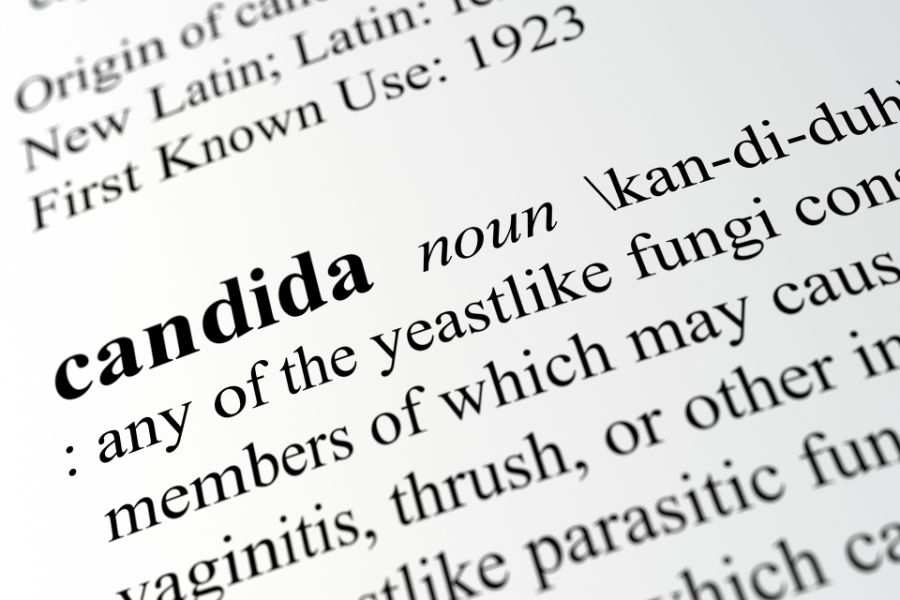
What causes Candida overgrowth?
Candida overgrowth occurs when the balance of microorganisms in the body is disrupted, allowing Candida—particularly Candida albicans—to multiply excessively.
The most common reasons it happens are:
- Antibiotic Use: Broad-spectrum antibiotics kill not only harmful bacteria but also beneficial gut bacteria that keep Candida in check. This can create space for Candida to grow unchecked.
- High Sugar & Refined Carbohydrate Diets: Candida thrives on sugars and simple carbohydrates. Diets high in sugary snacks, processed foods, and white flour can fuel overgrowth.
- Weakened Immune System: Immunocompromised individuals (e.g., people with HIV/AIDS, cancer, or those on immunosuppressive medications) are more prone to fungal overgrowth and invasive candidiasis.
- Hormonal Changes: Oestrogen dominance (e.g. during pregnancy, oral contraceptive use, or hormone replacement therapy) may promote vaginal Candida overgrowth by altering pH and immune response.
- Chronic Stress: Long-term stress can weaken immune function, raise cortisol levels, and alter gut flora—conditions that favour Candida overgrowth.
- Diabetes or Poor Blood Sugar Control: High blood glucose levels provide a food source for Candida and impair immune responses, increasing infection risk.
- Digestive Disorders & Gut Imbalance: Conditions like IBS or leaky gut may disrupt the natural bacterial-fungal balance, giving Candida the upper hand.
How can you test for Candida Overgrowth in the gut?
Testing for Candida overgrowth in the gut involves a combination of clinical evaluation, laboratory tests, and symptom history. No single test is 100% definitive, but the following methods are commonly used:
Stool Testing
Comprehensive stool analysis (often called GI or microbiome testing) can detect levels of Candida species in the large intestine.
- Looks for Candida albicans and other yeast species
- Often includes markers of digestion, inflammation, and bacterial balance
- Labs: Genova Diagnostics, Doctor's Data, or Invivo
Organic Acids Test (OAT)
This urine test detects D-arabinitol, a waste product produced by Candida overgrowth.
- High levels suggest yeast/fungal overgrowth
- May also assess other metabolic and mitochondrial markers
- Often used in functional medicine settings
Blood Antibody Tests
These check for immune responses to Candida:
- IgG, IgA, IgM antibodies to Candida albicans
- Elevated antibodies suggest overgrowth or chronic exposure
- Less specific for gut-only overgrowth, but useful in systemic cases
Candida DNA PCR Testing
Some advanced labs offer PCR stool or saliva testing that looks for genetic material from Candida, offering species-level identification.
Symptom-Based Assessment
While not diagnostic on its own, a symptom questionnaire can highlight patterns associated with overgrowth:
- Bloating, gas, sugar cravings
- Recurrent thrush or fungal infections
- Brain fog, fatigue, or skin issues
Does the “Candida Spit Test” work?
No. This DIY saliva test (spitting in water and watching for strands or cloudiness) is not scientifically validated and is considered unreliable by medical professionals.
How can you treat Candida overgrowth naturally?
Treating Candida overgrowth naturally involves a multi-pronged approach that includes dietary changes, probiotics, antifungal herbs, and gut support.
Diet Changes
A low-sugar, anti-inflammatory diet is key to reduce candida overgrowth:
- Avoid refined sugar, white flour, alcohol, and yeast-containing foods
- Focus on non-starchy vegetables, lean protein, healthy fats, and fermented foods (like sauerkraut or kefir)
- Avoid cruciferous vegetables (e.g. Broccoli and Cauliflower) as this can irritate the gut.
- Add turmeric to your food! Turmeric is a great natural anti-inflammatory.
Topical Creams
There are many herbal antifungals that can help soothe irritation and restore external balance. Topical creams help with Candida infections by delivering antifungal ingredients directly to the affected skin or mucosal area. This provides fast, localised relief from symptoms like itching, redness, and irritation.
Topical creams often contain ingredients that inhibit the growth of Candida albicans and other yeast species. These compounds disrupt fungal cell membranes, stopping the infection at the site.
- Common antifungals: clotrimazole, miconazole, or natural extracts like Horopito
- These agents reduce the fungal load without needing to enter the bloodstream
Many antifungal creams also contain soothing agents like aloe vera, calendula, or tea tree oil to relieve itching, burning, and inflammation commonly caused by yeast overgrowth.
Supplements
Probiotics help repopulate the gut with beneficial bacteria that suppress Candida. Probiotics are friendly bacteria that are important for a variety of bodily functions from digestion to sleep to immunity.
Certain probiotic bacterial strains are particularly effective in helping manage Candida albicans overgrowth by restoring gut flora balance, inhibiting fungal growth, and supporting the immune system. These strains mainly belong to the Lactobacillus and Bifidobacterium genera.
What are the best bacterial strains to use for Candida Overgrowth?
Lactobacillus rhamnosus GR-1
- Proven to inhibit Candida adhesion to vaginal and intestinal cells
- Supports vaginal health and immune defence
- Shown to reduce recurrence of vaginal thrush
Lactobacillus reuteri RC-14
- Works synergistically with rhamnosus GR-1
- Produces antimicrobial compounds that inhibit yeast growth
- Supports vaginal and gut microbiota
Lactobacillus acidophilus
- Produces lactic acid, lowering pH and making the environment hostile to Candida
- Inhibits fungal hyphae formation (a key virulence factor)
Bifidobacterium bifidum & Bifidobacterium longum
- Support gut immune responses
- Help re-establish microbial balance disrupted by antibiotics or diet
- May reduce Candida colonisation in the gut
Saccharomyces boulardii
- This one is actually a yeast rather than a probiotic but still can be effective in treating Candida overgrowth
- It works by competing with Candida albicans in the gut
- Enhances gut immunity and helps with detoxifying Candida byproducts
- Often paired with probiotics in antifungal protocols
Frequently Asked Questions about Candida and Candida Overgrowth
Is Candida a sexually transmitted disease?
Candida is not classified as a sexually transmitted disease (STD), but it can be passed between sexual partners. Candida can be transferred between sexual partners because it is a fungus that lives on the skin and mucous membranes, particularly in warm, moist areas like the mouth, genitals, and anus. During close contact—especially sex—there is direct skin-to-skin and mucosal contact, which creates an easy pathway for yeast cells to move from one person to another.
A healthy immune system, balanced microbiome, and intact skin barrier usually prevent Candida from overgrowing. However, if someone is already vulnerable (due to antibiotics, diabetes, hormonal shifts, etc.), they may be more likely to develop an infection after exposure.
How long does it take for Nystatin to cure Candida?
Nystatin typically starts working within 24 to 48 hours, but a full course of treatment usually lasts 7 to 14 days, depending on the location and severity of the Candida infection.
Can you permanently cure or treat Candida?
No unfortunately you cannot. If you experience frequent reoccurrence of Candida overgrowth then implementing permanent changes like the diet discussed earlier and regularly taking probiotics to manage your gut health would be the best approach to minimise the risk of Candida Overgrowth reoccurring.
Sources:
- https://www.frontiersin.org/journals/microbiology/articles/10.3389/fmicb.2019.00974/full
- https://pmc.ncbi.nlm.nih.gov/articles/PMC10127583/
- https://pmc.ncbi.nlm.nih.gov/articles/PMC3395238/
- https://journals.plos.org/plosone/article?id=10.1371/journal.pone.0107987
This article is for informational purposes only and is not a substitute for medical advice. Consult your doctor or healthcare provider before starting any supplements, treatments, or remedies. Ensure a varied and balanced diet and a healthy lifestyle before considering supplements. Supplements should not replace a balanced diet.

